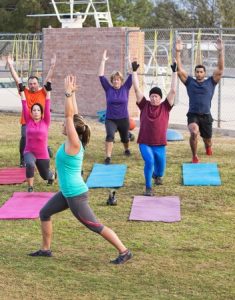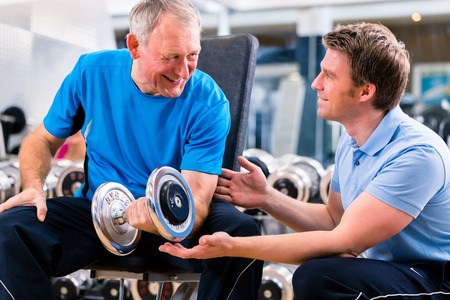The infamous bank robber Willie Sutton was once asked why he robbed banks to which he replied “because that’s where the money is”. This simple logic applies to running a business. If you want to make money you have to go to where the money is.
Business for personal trainers
The demographic most likely to hire a personal trainer are people that are in the Baby-boomer demographic. That cohort is most likely to have money to spend on personal training and the biggest desire to want to get into great shape. Specializing in working with this population is a win-win because they need your help and a larger percentage of them will have the resources to pay for it. Becoming a Baby-Boomer specialist requires certain skills that are unique to this population. Being in this demographic myself I can provide you with a unique perspective based directly on my own experience.

Challenges for baby boomers
Much of what I have learned about working with middle-aged clients comes directly from my own personal experience in the gym. I was in an auto accident in my thirties that darn near crippled me. I had spinal surgery in my early forties that did not go as well as expected. I was 42 when I started training again and had a lot to overcome. So, I would like to share some of that experience learned from my rehabilitation as it has some very transferable lessons. Here are some of the skills you will need to master to become a Baby-Boomer Specialist.
As we age there are changes in our bodies that present unique challenges to a personal trainer. Not only do people tend to put on weight but they lose flexibility, motor skills and strength. This decline is not inevitable and using a targeted approach you can greatly improve their physical capability. Being middle aged does not have to be the death knell to ones athleticism and functionality. Knowing how to address and correct issues of an aging population will make you a hot commodity and give you an edge up on your competition.
Training Components for Baby Boomers

Flexibility
There has been recent research that advises not to stretch prior to working out for two reasons. First it has not been shown to reduce training injuries and secondly it has been shown to hinder athletic performance. It is also ill-advised to stretch cold muscles, but nothing says you can’t warm up first. These research studies are generally performed using young athletes. It would be difficult to directly compare the findings with the effect on an older population.
Being a Baby-boomer myself I can tell you from personal experience that doing a general warm up followed by foam rolling and stretching target muscle groups prior to my workout has greatly improved my workouts. The tightness that is a characteristic of aging is greatly reduced after I warm up and then stretch. Since I started this ritual I have not experienced any tendon flair ups and I find my agility and movements are much more fluid during my training.
Going straight from a warm up to the weights lead me to have flare ups in certain tendons and these flair ups affected my progress. I had always included some dynamic stretches in my warm up but I didn’t perform any static stretches as it was said to be counter indicated.
My experience with this is anecdotal but that by its self does not render it invalid. If you have any skepticism I fully understand because it goes against the grain of popular opinion. However if you find that a particular client has postural issues that prevent them from reaching full depth in a squat or perhaps a shoulder issue, trying a few static stretches may help.
Remember not all research is valid for all people at all times. Take the time to see how individual people respond in the real world before you take any research as absolute truth.
Regardless of where you place it, stretching needs to be a key component in a Baby-Boomers training program because flexibility can become more of an issue as people age. Not to beat a dead horse but one of the reasons I stretch before I train is because I can give it my full focus when I’m fresh. If I am feeling like a wrung out dish rag then my commitment is not as vigorous as when I am fresh. Even if I opt to have a client stretch after training I will try to get them to do some dynamic stretches as part of their warm up beforehand.
Motor Skills
I was 42 years old when I first started lifting weights again. Not only had I not lifted since I was in my early thirties but the spinal injury had negatively impacted my functionality in every respect. My motor skills were about on par with a drunken sailor on a three day shore leave. I was seriously overweight myself and had nerve damage to my S-1 nerve root. In order to improve my motor skills without getting hurt I developed a progression that is directly transferable to working with Baby-Boomers in general.
Using suitable training devices that assist a person to perform challenging movements is a key component of developing motor skills. Imagine being a couch potato for thirty years and then trying to do lunges. That is exactly the type of thing you will often ask your clients to do.

How do you help to develop the motor skills required without injuring a person in the process?
In the example of lunges what I found that worked for me and for my balance challenged clients is to do them inside of a power cage with one hand above one of the catch pins. To get their feel and form perfected in a safe way I have a person hold the pin like a handrail until they get the feel.
As they progress they can hold their hand above it to give them a safety net should they lose their balance. After they develop greater motor skills I have them perform body weight lunges or Bulgarian split squats. You can see how this progression unfolds as a person develops greater motor skills.
With a little imagination you can think of many progressions that develop motor skills in a safe way. To just throw a person on top of a wobble board and have them try to keep upright is like throwing a toddler in the lake to teach him how to swim. You have to build confidence and progress toward more challenging movements over time. Many people have been inactive for decades. Their motor skills need to be relearned over a period of time.
Strength
During my personal comeback strength was the least of my problems. I am naturally an ectomoph with endomorphic tendencies so I can put on muscle easily but tend to gain fat along with it. I was formally a carpet cleaner by trade and had been moving heavy furniture around on a daily basis. Right off the rip my strength was above average for a new lifter.
Having strength is not the same as having muscular balance. I was much stronger and tighter on my left side than on my right. If you have ever cleaned a carpet you know you are doing a rowing motion on one side constantly while the other side gets a free ride. That is a surefire recipe for strength imbalance.
Not only was my strength uneven but my flexibility was greatly different from one side to the other. Doing bilateral exercises will do very little to correct strength imbalances. It’s nearly impossible to know if both limbs are firing with equal force. The best way to identify and correct any strength imbalances is to perform unilateral exercises. However many of these exercises require a great deal of balance and core strength. You simply can’t get an out of shape person to perform some of the best unilateral exercises without a carefully executed progression.
I am a huge fan of looking up progression ideas on YouTube. If you need a good progression all you need to do is spend a little time researching it on the web, or ask another trusted trainer for advice. Doctors ask other physicians for a consult all of the time. Most people will gladly give you their advice because it shows them that you respect their opinion. You certainly don’t want your ego to stand in the way of providing the best service you can for your client.
It is very rewarding to work with people in a way that greatly improves their lives. Being a Baby-Boomer Specialist is a very rewarding pursuit. People that exercise are able to do things that other people their age can only dream of. It is also a sound business move because it is a large demographic that needs your service and has the money to pay for it.
Do you work with Baby Boomers, or want to? Are you a Certified Personal Trainer? LEARN MORE >>
More Articles About Training Baby Boomers:
Business is Booming with Baby Boomers >>
How to Market Your Training Services to Baby Boomers >>
John Rutnik is a NFPT Certified Personal Trainer. He holds an AAS in Electrical Technology and has been a certified personal trainer since 2008. John has been involved in physical fitness and weight training since the late 70’s and is an avid outdoors man. He became a personal trainer after rehabilitating himself from a spinal injury he sustained in a car accident and losing 70 pounds. John later obtained ISSA Certifications as both a Fitness Trainer and Specialist in Sports Nutrition and became Lead Fitness Trainer at Anytime Fitness in Schenectady NY. His training philosophy is “no man left behind,” everyone deserves a chance to succeed.


